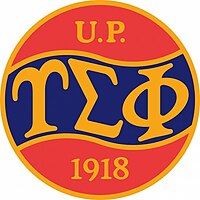Upsilon Sigma Phi
| Upsilon Sigma Phi | |
|---|---|
| ΥΣΦ | |
 | |
| Founded | 1918 University of the Philippines Diliman, Quezon City |
| Type | University |
| Motto | We gather light to scatter |
| Colors | Cardinal Red Old Blue |
| Symbol | Fraternity seal |
| Flower | Pink Rose |
| Chapters | 2 (U.P. Diliman/U.P. Manila and U.P. Los Baños) |
| Members | 3,500+ total lifetime |
| Headquarters | University of the Philippines |
| Website | http://www.upsilon.com |
Founded in 1918, the Upsilon Sigma Phi (ΥΣΦ) is the oldest Greek-letter organization and fraternity in Asia.[1][2] It is the oldest student organization in the University of the Philippines that has been in continuous existence since its founding and predates the Philippine Collegian which was established in 1922, and the UP Student Council which was revived in 1924. It is also an exclusive fraternity where membership is by invitation only.
History
It was formally organized on November 19, 1920 in a meeting held at the Metropolitan Restaurant in Intramuros. Four months later, on March 24, 1921, the Greek letters ΥΣΦ standing for the initials of the name "University Students Fraternity" was formally adopted. In the same year, the fraternity also completed its organization with rituals prepared by Graciano Q. Rico, motto (We gather light to scatter), colors (cardinal red, old blue). The head is known as the Illustrious Fellow and the first honorary fellow, University Regent Conrado Benitez, was inducted into the Fraternity. He wrote the Upsilon Hymn which later would be sung before and after every formal meeting.[3]
Chapters
The Upsilon Sigma Phi has two chapters. A combined UP Diliman/UP Manila chapter and a second one in UP Los Banos.[4]
Upsilonians during WWII
During World War II, some members took the field. Among the Upsilonians who gave up their lives were Wenceslao Q. Vinzons (former UP Student Council President, youngest delegate to the 1934 Constitutional Convention, and Governor of Camarines), Agapito del Rosario (Mayor of Angeles, Pampanga), and José Abad Santos (Secretary of Justice and Chief Justice of the Supreme Court), all of whom were executed for refusing to swear allegiance to the Japanese Empire.
Upsilonians during the Marcos Years
The administration of President Ferdinand E. Marcos saw Upsilon members lead opposing sides in the leadership of the Philippines. With the administration was Marcos, Senate President Arturo M. Tolentino, Secretary of Education and former UP President Onofre Corpuz, Chief Justice Querube Makalintal (who after his retirement would be elected Speaker of the Batasang Pambansa), and Batasan Speaker Nicanor Yniguez among many others. Leading the opposition were Senators Benigno S. Aquino, Jr., Gerardo Roxas, Salvador H. Laurel and Mamintal A.J. Tamano.[5]
Waging an ideological war from the mountains were members with the left such as Melito Glor[6] and Medardo Arce. After their deaths, the New People's Army Southern Luzon and Mindanao Commands would, in their honor, be named the Melito Glor Command and the Medardo Arce Command respectively. Fighting for Muslim rights and greater autonomy were Senators Ahmad Domocao A. Alonto[citation needed] and Mamintal A.J. Tamano.
Notable Members
- Ferdinand Marcos – Philippine President, Senate President and Ilocos Norte Representative
- Joker Arroyo – Senator, Executive Secretary and Makati Representative
- Richard Gordon – Senator and Tourism Secretary
- Salvador P. Lopez – Foreign Affairs Secretary and University of the Philippines President
- Wenceslao Q. Vinzons – World War II War Hero and Martyr, 1935 ConCon delegate
- José P. Laurel – Philippine President, Senator and Supreme Court Justice
- Arturo M. Tolentino – Senator
- Salvador H. Laurel – Philippine Vice President, Senator and Assemblyman
- Francis Pangilinan – Senate Majority Floor Leader and Quezon City Councilor
- Alfredo E. Pascual – University of the Philippines President
- Gregorio Pio Catapang – Chief of Staff, Armed Forces of the Philippines
- Benigno S. Aquino, Jr. -youngest elected Senator, Governor and Mayor
